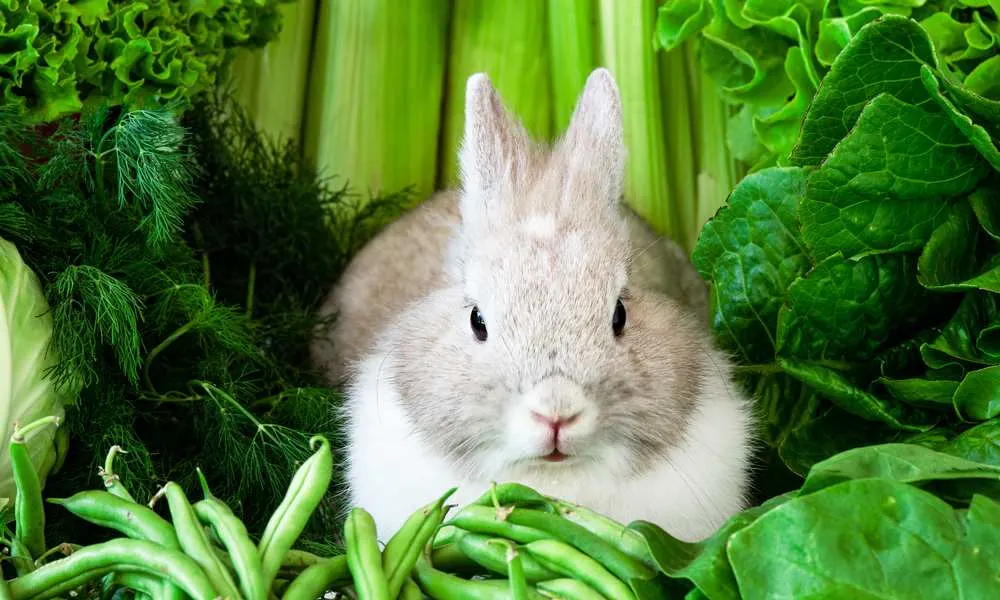
Feeding A House Rabbit – Greens And Veggies
Contrary to many people’s beliefs, your pet rabbit is by no means an omnivore. All rabbits are strictly herbivores – meaning they have a closely selected list of foods they can eat.
Your pet rabbit can eat either leafy or non-leafy greens – no complication there.
Still, choosing food to feed your rabbit might be more complex for a new owner than it looks. That’s why we have prepared a list of EXACTLY what and what not to feed your house rabbit.
Let’s have a look.
What Can Rabbits Eat?
In the table below you can see what fruits and vegetables are healthy for your pet and why.
| THE FOOD | THE HEALTH BENEFITS |
|---|---|
| CARROTS: | Of course, carrots are the first to appear on the list, but they should be served chopped (not full-piece carrots). The healthiest part of this vegetable is the carrot top. This treat is rich in vitamin A, B6, C, potassium, etc. Do not give your rabbits carrot roots – they are high in sugar. |
| LETTUCE: | If you are feeding your rabbit lettuce, go for darker romaine lettuce. They are low in calories and contain high levels of magnesium and potassium. Feeding your rabbit lettuce will keep him safe from becoming fat. |
| CELERY: | Celery is a close second to lettuce. It is an excellent source of vitamins B1, B2, and B6. Baby bunnies love celery, and this can become a great daily treat for them. But be careful not to go overboard – too much celery can cause digestive issues. |
| LEMON BALM: | Feeding your rabbit lemon balm is actually very important for maintaining a good immune system. This food has antibacterial properties, and a little bit of lemon balm every once in a while will surely keep them in good shape. |
| BROCCOLI: | Chopped broccoli and its leaves are the number one leafy treat for your pet rabbit. It’s rich in iron, calcium, and all sorts of vitamins. Many owners consider broccoli as a rabbit superfood. |
| KALE: | Kale is also a great example of energy food. Although people can eat larger amounts of kale, this should be given to rabbits just as a treat. It will significantly boost their magnesium level. |
| BOK CHOY: | Bok choy is a much stronger choice of food, and it should only be given to rabbits that have passed six months. It contains oxalic acid, and therefore it may be harder for bunnies to digest it. When giving bok choy to your rabbit, always include lots of water. |
| BASIL: | Many professionals nowadays recommend including basil in your rabbit’s diet because it contains anti-inflammatory properties and protects your rabbit from gaining that excessive weight. |
| BELL PEPPERS: | Feeding your rabbit bell peppers is a good idea, but it should only be done in small portions. These vegetables are low in sugar and calories, which is good, but it is essential that you don’t go overboard. |
| ASPARAGUS: | Asparagus is an excellent snack for your pet rabbit because it is low in calories and high in chromium. Also, it protects your rabbit from the dangers of high levels of glucose in its blood. |
| APPLES: | What pet doesn’t love apples? This fruit is a natural antioxidant, but you should give them to your rabbit moderately because some of them are high in sugar. |
You have seen a narrow selection of the healthiest food for your pet rabbit. However, this is not all, of course. There are many more choices you can choose from, and here they are:
- Parsley
- Spinach
- Cucumber leaves
- Mint
- Raspberry leaves
- Cilantro
- Fennel (leafy tops and base)
- Borage leaves
- Sprouts (1-6 days after sprouting)
- Mache
- Papaya
- Mango
- Apricot
- Berries (any type)
- Nectarines
From the lists above, we have come to a conclusion that shows the nutritional needs of an average house rabbit. Let’s break down the facts.
Here are an average rabbit’s nutrient requirements:
| WATER: | 40 teaspoons per day |
| PROTEINS: | Lysine, valine, leucine |
| FATS: | Vegetable oil |
| CARBOHYDRATES: | Sugar, starches, fiber |
| VITAMINS: | Vitamins A, D, E, K, B |
| MINERALS: | Magnesium, sodium |
To sum up the preferred food choices and proper nutrition, here are some tips:
- Provide your pet rabbit with fresh and clean drinking water (check the bowl twice a day)
- Provide your rabbit with good-quality grass/hay in his cage
- Do not go overboard with root vegetables like carrots – give them only as treats
- Wash the leafy vegetables before giving them to your rabbit
- Give them their meals in even quantities
- Monitor their diet and what food/treats they prefer or refuse to eat

Commercial Food
Feeding your rabbits greens and veggies is great, but there is no fault in going out and buying some good-quality commercial food. It can do wonders for their immune system.
Here are the top picks: Rabbits commercial food.
| FOOD BRAND AND NAME | KEY POINTS |
|---|---|
| “Oxbow Essentials Bunny Basics Young Rabbit Food” | Meant for younger rabbits, high in dietary fibers, comes in 10 lbs |
| “Small Pet Select Rabbit Food Pellets” | Hay is the primary ingredient, high protein levels, contains soybeans |
| “Kaytee Supreme Fortified Daily Diet Rabbit Food” | Affordable, a balanced diet, contains wheat |
| “Science Selective Junior Rabbit Food” | Good for young rabbits, no additives or sugars, contains alfalfa hay |
| “Sherwood Pet Health Adult Rabbit Food” | Vegetarian-based diet, optimal protein levels, recommended by vets |
Read Also: Can Rabbits Eat Bermuda Hay?
For more information about commercial rabbit food and its benefits, visit the link below:
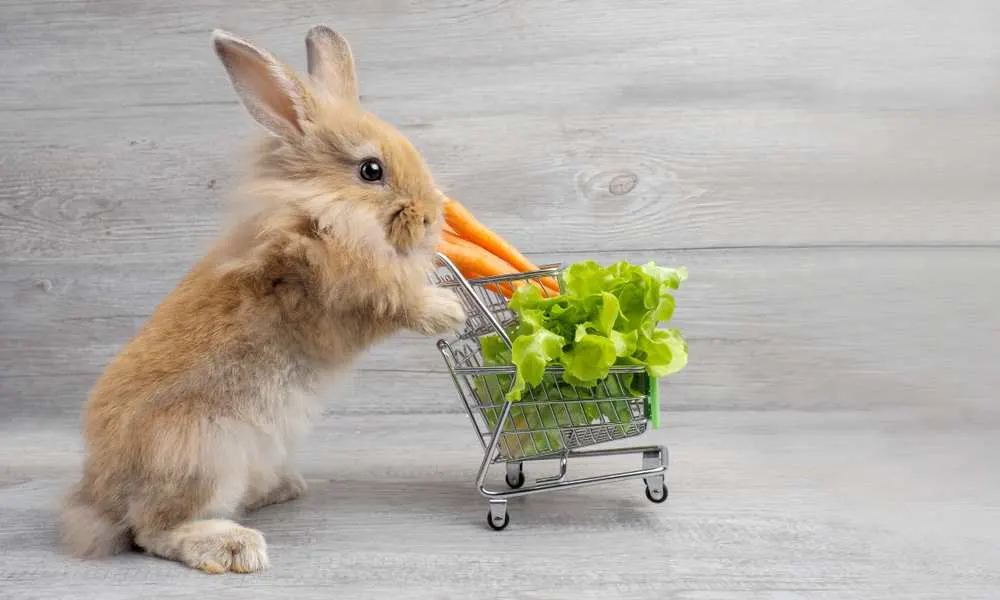
Feeding Charts
For a better understanding of just how much and what you should feed your pet rabbit at different stages of his life, here are some charts that could help you:
| BABY RABBIT (1-3 WEEKS): | In the first few weeks of its life, you should feed your rabbit lots of milk. This will help them develop antibodies against diseases. |
| A JUVENILE (3-7 MONTHS): | During this time, you can feed your rabbit unlimited amounts of hay and pellet. They are incredibly energetic during this time, and they need as many vitamins as they can get. |
| YOUNG ADULT (7 MONTHS – 1 YEAR): | Before your pet turns 1, you should slightly enrich the diet with various fruits and vegetables. |
| GROWN RABBITS (2-5 YEARS): | Grown rabbits will need a lot more food, so for a 6-pound rabbit, you will need ¼ cup of pellets. Keep track of your rabbit’s weight. |
| SENIOR RABBITS(6 YEARS +): | Basically, the diet for senior rabbits is almost the same as for grown-ups. After they have passed six years, increase their intake of calcium. |
Here is a feeding chart made according to weight at different stages of life:
The food we are focusing on is green grass.
| PERIOD OF LIFE | WEIGHT | QUANTITY PER DAY |
|---|---|---|
| Baby | 600-700 gr | 200 gr |
| Adult male | 4-5 kg | 600 gr |
| Adult female | 4-5 kg | 600 gr |

What Can Rabbits NOT Eat? Attention – Toxic For Your Rabbit
We have covered a large section of foods that are good for your rabbit. Now, we have to focus on what food your pet rabbit should avoid. Some ingredients that may seem like a good idea are toxic to your little furry friend. Let’s get right down to clear this up:
NO GRAINS!
Avoid feeding your rabbit any type of grains: bread, crackers, cereal, rice. This food is extremely small, and your pet can start choking very quickly.
“FAST FOOD”
Fast food is a red flag for us but is even more dangerous if we feed it to our rabbits. Fast food is loaded with unhealthy carbohydrates and sugars., so your rabbit could be looking at a heart attack after a few huge bites of your leftovers.
MEAT IS FORBIDDEN
Like we said earlier, rabbits are strictly herbivores, so meat-eating is not in their blood. Don’t try to give them any meat leftovers because the chances that they will successfully digest it are almost zero. They will just end up with severe stomach aches.
DAIRY PRODUCTS
Strong dairy products such as cheese, yogurt, and large amounts of milk should not be given to your pet rabbit, especially when it is still a baby. Although calcium levels should be maintained, you should watch out for total red flags like butter and ice cream.
NUTS ARE A NO
Like meat, nuts and nut products, in general, are not the type of food you should give to your rabbit because of their high-fat levels. Even with small quantities of this food, stomach problems and diarrhea are a strong possibility.
See Also: Can Rabbits Eat Walnuts?
WATCH OUT FOR RHUBARB LEAVES!
Even though rabbits are pronounced herbivores, some leaves may trouble their diet – rhubarb leaves. This “snack” contains exceptionally high levels of oxalic acid, which can damage your rabbit’s kidneys.
POISONOUS AVOCADOS
To you, avocado is a great refreshment, but to your pet rabbit, this is a poisonous vegetable. It contains parts that are toxic to your pet, and you mustn’t let it eat it.
APPLE SEEDS
We said that apples are a good treat for your pet rabbit, but you should watch out for apple seeds. These tiny pieces contain toxic levels of arsenic that can be deadly for your pet.
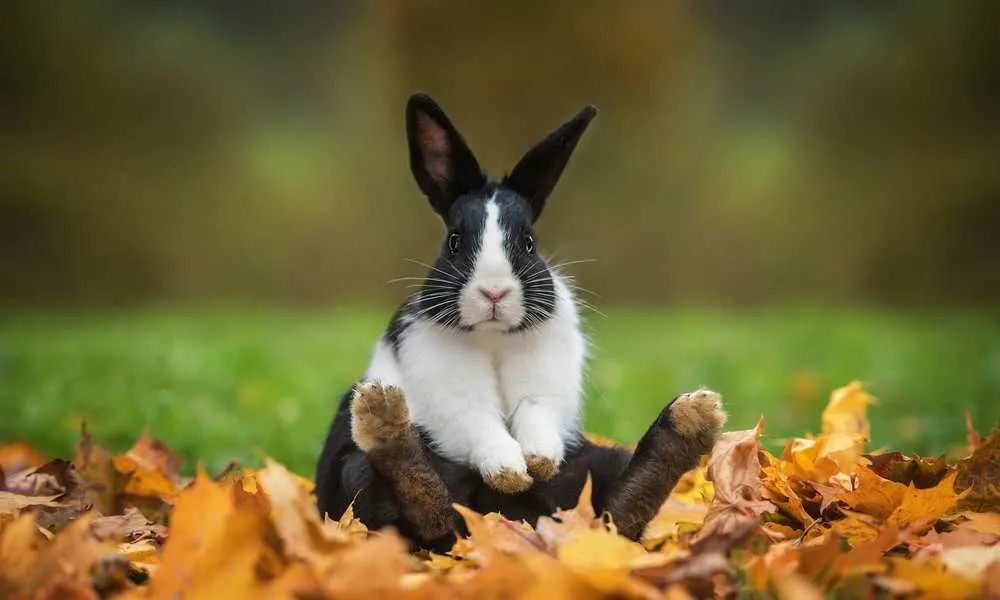
Wild Rabbits Eating Their Own
In the animal kingdom, it is not unusual when an animal eats their own cubs. Although this might sound frightening to you – it is possible.
Pet rabbits are not going to eat their babies, but if you adopt a wild rabbit, don’t be surprised if this happens before your eyes. Let us explain.
There are a couple of reasons why wild rabbits sometimes have no choice but to eat their own cubs.
First, there is the fact that, in the wilderness, rabbits are at the lowest level of the food chain. This means that they rarely have a variety of food options. This kind of food shortage can lead to starving, and starving can lead to eating their own cubs.
Another reason for this unusual feeding method is that the baby rabbits’ mother tends to eat her own cubs if she feels that they have been suffering from some kind of illness.
Are there ways you can prevent this from happening with your wild pet rabbit? Yes.
Advice no. 1
You need to make your wild rabbit comfortable with the new environment. The feeling of the constant threat of survival should come to a stop, and after you have achieved this, you will see a huge difference in its behavior.
Advice no. 2
If you feel that the baby rabbits are still in danger, despite the change in environment and everything, try separating them from their mother for some time. This will surely be difficult, but it might be the only way to save their lives. After some time has passed, the rabbit’s mother might give up entirely on the eating habit.
Advice no. 3
Maybe her eating her cubs is caused by stress. In this case, you need to distract the rabbit’s mother with some toys or food. After some time, her attention would switch to the new items around her babies will be safe.
Anyways, this is only for those who have picked up a wild rabbit from the forest and decided to give it a home.
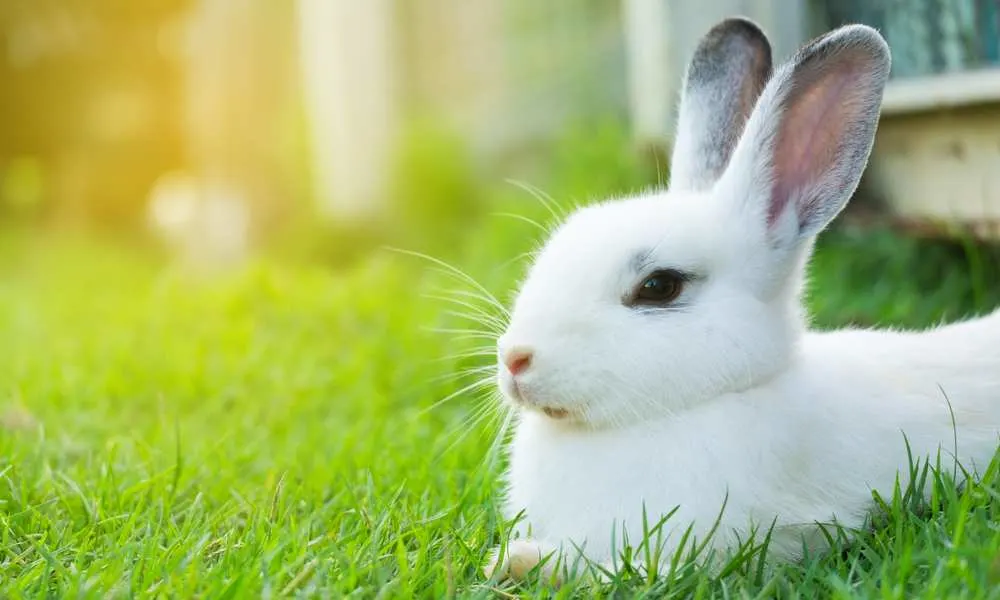
Wild vs. Domestic
Since you can adopt both domestic and wild rabbits, it wouldn’t hurt to know the difference between them. That’s where we come in.
You can easily spot the difference with the help of these categories:
- Approachability
- Movement
- Coloring
- Head shape
- Ears
- Size
- Weight
- Companionship
Approachability – wild rabbits are not as nearly approachable as domestic. If you come across a wild rabbit, the chances are that it won’t freely approach you. It will just run away.
Movement – Domestic rabbits don’t move as freely as wild ones. They will probably explore the territory around them without any sudden movements.
Coloring – Wild rabbits are darker than domestic ones. Usually, a wild rabbit will have a darkish brown coat, and a domestic rabbit will be either grey or white.
Head Shape – Domestic rabbits have a more rounded head shape. On the other hand, the shape of the wild rabbit’s head will be thinner and longer.
Ears – Wild rabbits will have straight up-right ears because they rely highly on their hearing when they are roaming through the forest. Domestic rabbits, as we all know them, have cute floppy ears.
Size – Wild rabbits are considerably heavier and higher in size. Domestic ones will more likely be dwarf-sized.
Weight – Logically, domestic rabbits will be chubbier than the wild ones since they receive regular meals daily, while the wild breed has to figure it out for themselves.
Companionship – Unlike domestic rabbits, those who live in the forest will move in groups of 4-10. Domestic rabbits are more “isolated” in nature.

Is My Rabbit Obese?
Making your rabbit overweight is really not that hard. These are miniature animals, and if you don’t pay attention to how much you are feeding them, they can quickly become too chubby.
Of course, having a tubby pet rabbit is adorable, but you can’t say the same about their health. First, you will have to check the weight, and you can do that by:
- Looking at him from both sides and reviewing the waist
- Feeling your rabbit’s tummy – it shouldn’t appear bloated
- Checking out if you can feel their ribs
- Touching the base of their tale – it shouldn’t be fat
Besides the regular check, here are the symptoms that will confirm your rabbit is obese:
- Difficulty grooming and excessive shedding
- Uncontrollable drinking water after meals
- Inability to posture correctly
- Decreased activity level
Before your rabbit develops some severe illness, you can take care of this by:
- EXERCISING – If you are an owner of a cute domestic rabbit, then the best way to make it lose that excess weight is to give it free space to run. Domestic rabbits that are entirely accustomed to their new “home environment” will love playing around in the backyard while munching on some grass.
- IMPROVING THE DIET – The best way to enhance your overweight rabbit’s diet is to increase the amount of pure green grass in their diet, measure their weight frequently to keep track and limit their daily meals.
Fun Fact: The most common reason for rabbit obesity is the space they are kept in. In Britain, more than 25% of domestic rabbits are kept in small hutches with no room to move – thus, they gain weight twice as easily.
Health Threats
Since we have confirmed that obesity in rabbits is a serious problem, we should also mention the consequences that it can have if we don’t pay attention to what we are feeding our pets.
Here is an overview of the health issues that threaten an obese rabbit:
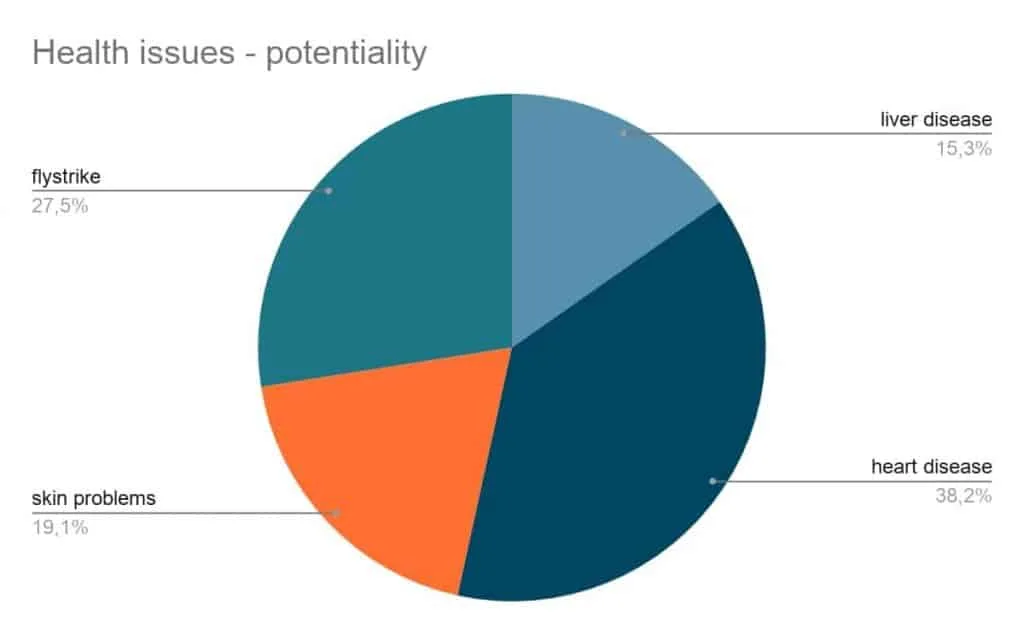
HEART DISEASE
It is extremely hard to predict heart disease in rabbits, but sadly it is the most common outcome when it comes to obesity. For example, the symptoms that correlate most with this disease are:
- Tiredness
- Decrease of activity
- Reduces appetite
- Bloating / weight gain
- Increased breathing rate
Before this turns out to be fatal, you can take some smart steps and prevent it by going to the vet the minute you witness some strange symptoms.
FLYSTRIKE
Flystrike is when a fly lays its eggs on a rabbit’s fur. This can cause severe illnesses and even death. Flystrike is most likely to occur because of:
- A dirty environment
- Diarrhea
- Recent wounds
- Obesity
Luckily, there are ways in which you can treat this disease. You can give your rabbit pain medication, antibiotics, a fluid drip, or just take them to the vet and let him have a thorough examination and cleaning of the fur.
LIVER DISEASE
Liver disease, otherwise known as hepatic lipidosis, happens when there is too much fat in the rabbit’s organism or just a sudden change in the diet. So, if your rabbit is already accustomed to one diet, don’t try to change it. Common signs of hepatic lipidosis are:
- Loss of appetite
- Change in weight
- Dehydration
- Decreased activity
- Depression
There are ways in which you can treat this disease. Depending on the seriousness of the condition your pet rabbit is in, you can choose from a variety of treatments. The most common way of dealing with liver disease in rabbits is intravenous fluids, pain medication, adding fiber-based supplement foods to its diet, or undergoing a surgical procedure.
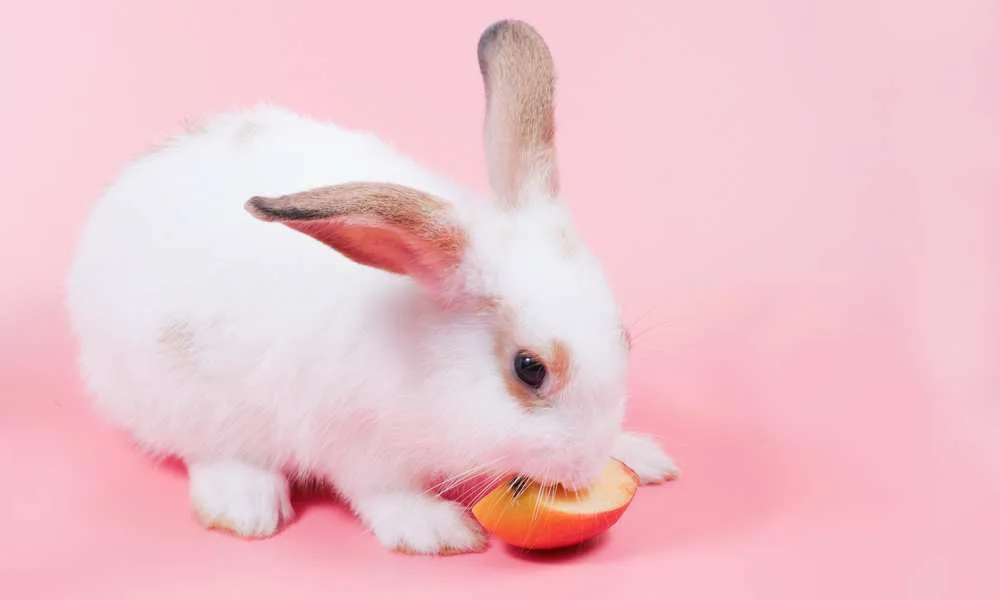
Fun Facts
Rabbits make pretty cute pets, but cuteness is not everything. These little fluffy animals possess many interesting facts that make them extraordinary. Let’s mention some of them.
1. Surprisingly – They Can’t Live On Just Carrots
- Although it may come as a surprise, you can’t just feed your pet rabbit carrots and expect him to be okay. Your rabbits need more food, more vitamins, and more proteins to stay healthy. Also, eating carrots alone is not good at all because they are extremely high in sugar.
2. Baby Rabbits Are Also Called Kittens
- We are used to calling baby rabbits bunnies, but that’s not entirely correct. Technically, the correct word for baby rabbits is kits. On that note, female rabbits are referred to as does and males as bucks.
3. They Can Eat Their Own Feces
- It’s true. Rabbits can sometimes eat their own poop the first time and then process it again. It may seem highly anti-hygienic, but it’s actually very common for this breed.
4. They Are Really Good At Jumping
- Rabbits, especially wild ones, are great at jumping. This capability makes it easier for them to hunt their food and get away from their predators – and there are a lot of them.
5. Their Teeth Never Stop Growing
- Rabbits’ teeth grow and develop throughout their entire life. They need those strong teeth because of their way of feeding – chewing plants.
6. Their Ears Help Them Cool Off
- Those cute fluffy ears are not just there for looks. They also have a purpose. Rabbit ears help them stay cool during hot summer days. They can rotate those ears as much as 270 degrees. Wow!
7. They Live In Warrens
- Wild rabbits live in warrens – tunnels specially made for sleeping and nesting. Don’t be fooled; warrens are enormous, and they have multiple entrances. They are like underground rabbit castles.

